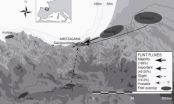(Press-News.org) A NASA satellite captured an image of the western quadrant of Typhoon Matmo brushing over the eastern Philippines on July 20.
NASA's Terra satellite passed over Typhoon Matmo on July 20 at 02:15 UTC and the Moderate Resolution Imaging Spectroradiometer or MODIS instrument aboard captured a visible image of the storm. The MODIS image showed a thick band of thunderstorms west of the storm's center were sweeping over the eastern Philippines.
The Joint Typhoon Warning Center (JTWC) noted that animated multispectral satellite imagery on July 21 showed that convection (rising air that forms thunderstorms) around the center of circulation had strengthened from the previous day. That stronger convection was evident in a thick band of thunderstorms in the southern quadrant of the storm that wrapped into the center. That same thick band of thunderstorms was also visible on the MODIS image of July 20.
On July 21 at 1500 UTC (11 a.m. EDT) Typhoon Matmo's maximum sustained winds were near 70 knots (80.5 mph/129.6 kph). Matmo was centered near 18.9 north latitude and 125.0 east longitude, about 500 nautical miles south-southwest of Kadena Air Base, Okinawa, Japan. Matmo is moving to the northwest at 11 knots (12.6 mph/20.3 kph) while intensifying. The Japan Meteorological Agency has issued a yellow alert advisory for Okinawa-honto Chiho that includes thunderstorms and high waves as Matmo draws nearer.
JTWC forecasters said that improving upper-level conditions and warm sea surface temperatures in the Philippine Sea are conducive for further intensification, and they expect Matmo's sustained winds to peak near 105 knots (120.8 mph/194.5 kph) sometime on July 23 as it approaches northern Taiwan.
INFORMATION:
Text credit: Rob Gutro
NASA's Goddard Space Flight Center
NASA satellite sees Typhoon Matmo brush eastern Philippines
2014-07-21
ELSE PRESS RELEASES FROM THIS DATE:
Stem cells aid muscle repair and strengthening after resistance exercise
2014-07-21
CHAMPAIGN, Ill. — A new study in mice reveals that mesenchymal (mezz-EN-chem-uhl) stem cells (MSCs) help rejuvenate skeletal muscle after resistance exercise.
By injecting MSCs into mouse leg muscles prior to several bouts of eccentric exercise (similar to the lengthening contractions performed during resistance training in humans that result in mild muscle damage), researchers were able to increase the rate of repair and enhance the growth and strength of those muscles in the exercising mice.
The findings, described in the journal Medicine and Science in Sports and ...
Climate: Meat turns up the heat
2014-07-21
Stanford, CA—Eating meat contributes to climate change, due to greenhouse gasses emitted by livestock. New research finds that livestock emissions are on the rise and that beef cattle are responsible for far more greenhouse gas emissions than other types of animals. It is published by Climactic Change.
Carbon dioxide is the most-prevalent gas when it comes to climate change. It is released by vehicles, industry, and forest removal and comprises the greatest portion of greenhouse gas totals. But methane and nitrous oxide are also greenhouse gasses and account for approximately ...
Can amyloid plaque in Alzheimer's disease affect remote regions of the brain?
2014-07-21
New Rochelle, NY, July 21, 2014—In Alzheimer's disease, accumulation of amyloid plaque in the brain is believed to play an important role in many characteristic disease symptoms, including memory loss and other mental state changes. But how these plaque deposits affect brain function is not well understood. Important new study results showing that plaque buildup in one area of the brain can negatively affect metabolism in a more distant brain region have been published in Brain Connectivity, a peer-reviewed journal from Mary Ann Liebert, Inc., publishers. The article is ...
Increased overall survival for advanced stage non-small cell lung cancer patients is associated with availability of less toxic chemotherapy
2014-07-21
DENVER – A 10-year population-based study shows that increased availability of better systemic chemo- and targeted-therapies for patients with advanced non-small cell lung cancer (NSCLC) coincides with increased usage of these therapies. This in turn leads to a significant increase in overall survival.
Researchers from the British Columbia Cancer Agency, Vancouver, Canada, performed a retrospective chart review of all patients referred to the agency with advanced stage (IIIB or IV) lung cancer and grouped the patients into 4 one-year time frame cohorts; one termed "baseline" ...
ROS1 gene fusions are found in 2.4 percent of Asian patients with lung adenocarcinoma
2014-07-21
DENVER -- ROS1 fusion genes were successfully detected independent of gender or smoking history in young East Asian patients with lung adenocarcinoma, a histological subgroup in non-small cell lung cancer (NSCLC), using multiplex reverse transcriptase-polymerase chain reaction (RT-PCR) and immunohistochemistry (IHC) diagnostic tests.
In NSCLC treatment algorithms, a personalized therapy approach is now being taken based on the genetic characteristics of the cancer. Patients with specific oncogenic molecular aberrations, for example EGFR mutations and ALK gene fusions, ...
New accurate epigenetic test could eliminate unnecessary repeat biopsies for prostate cancer
2014-07-21
New York, NY -- More than one million prostate biopsies are performed each year in the U.S. alone, including many repeat biopsies for fear of cancer missed. Therefore there is a need to develop diagnostic tests that will help avoid unnecessary repeat biopsies. Two independent trials have now validated the performance of an epigenetic test that could provide physicians with a better tool to help eliminate unnecessary repeat prostate biopsies, report investigators in The Journal of Urology®.
In the previously reported independent MATLOC (Methylation Analysis To Locate Occult ...
Oregon chemists eye improved thin films with metal substitution
2014-07-21
EUGENE, Ore. – (July 21, 2014) – The yield so far is small, but chemists at the University of Oregon have developed a low-energy, solution-based mineral substitution process to make a precursor to transparent thin films that could find use in electronics and alternative energy devices.
A paper describing the approach is highlighted on the cover of the July 21 issue of the journal Inorganic Chemistry, which draws the most citations of research in the inorganic and nuclear chemistry fields. The paper was chosen by the American Chemical Society journal as an ACS Editor's ...
Overcoming barriers to physical activity for African-American women
2014-07-21
AURORA, Colo. (July 21, 2014) - According to the Centers for Disease Control, approximately four out of five black women are overweight or obese and 36 percent meet physical activity objectives as determined by the CDC. That's compared to 50 percent of white women meeting the same objectives.
A study conducted by the Center for African American Health and the University of Colorado School of Medicine's Center for Women's Health Research finds that African American women whose hairstyle is affected by perspiration may avoid physical activity altogether. Prior studies ...
Study offers new clues about the source of racial health disparities
2014-07-21
A first-of-its-kind study by researchers at USC and Loyola Marymount University (LMU) has found evidence that the persistent health disparities across race may, in part, be related to anxiety about being confronted by negative racial stereotypes while receiving healthcare.
Stereotype threat, which is the threat of being judged by or confirming a negative stereotype about a group you belong to, has already been shown to influence the outcome of standardized testing, such as performance on the SAT (the most widely used college admissions exam). For example, when confronted ...
The economic territory of Upper Palaeolithic groups is specified by flint
2014-07-21
This news release is available in Spanish.
Never before had the mobility patterns and management of lithic resources in the Upper Palaeolithic been determined so precisely. The study of flint remains found in the open-air Ametzagaina site in Donostia-San Sebastian has determined the economic territory of the human groups that lived there for about 2,000 years. The paper, Where to and What for? Mobility Patterns and the Management of Lithic Resources by Gravettian Hunter-Gatherers in the Western Pyrenees, has been published in the Journal of Anthropological Research.
The ...




